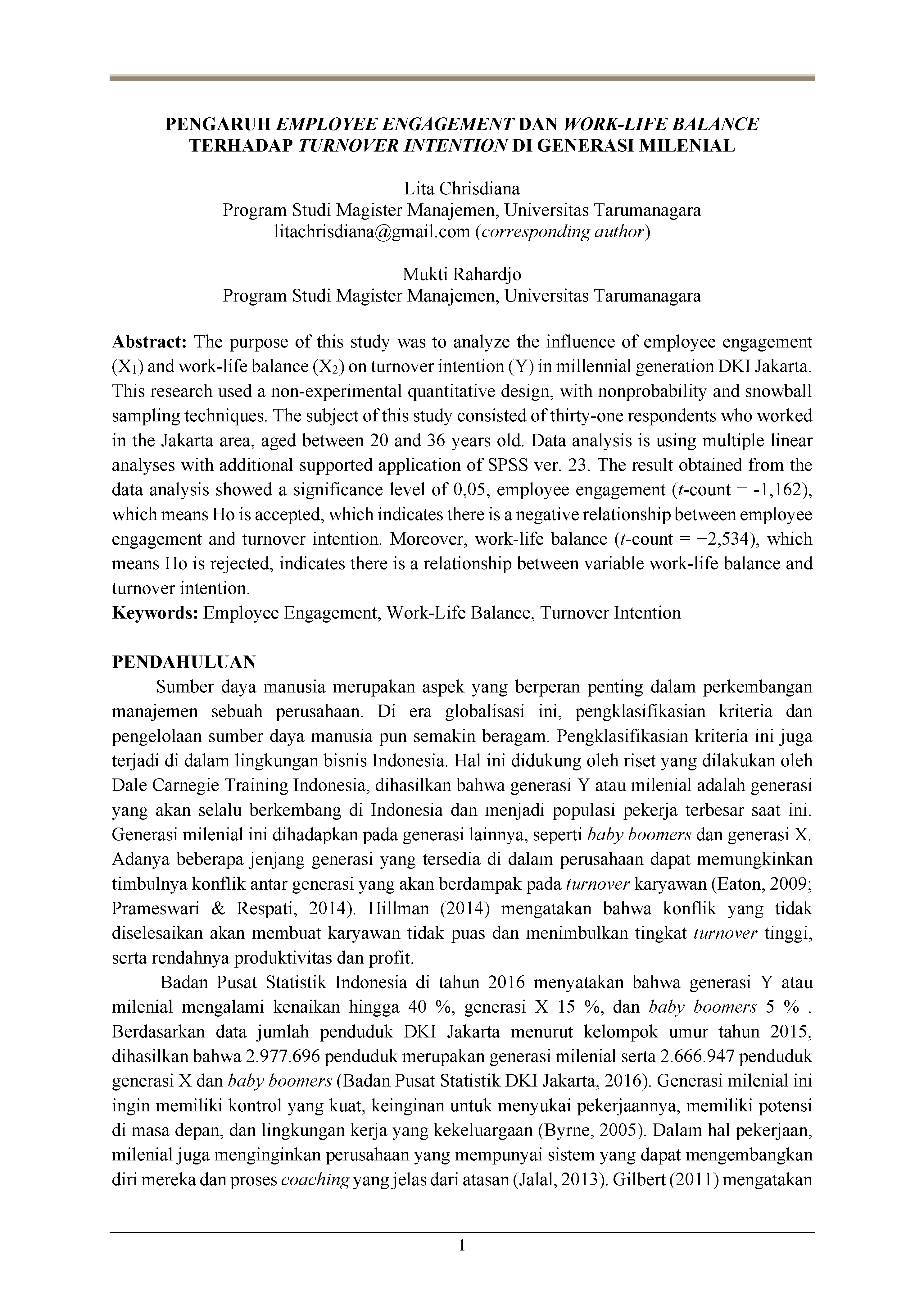Pengaruh employee engagement dan work-life balance terhadap turnover intention di generasi milenial
Main Article Content
Abstract
The purpose of this study was to analyze the influence of employee engagement (X1) and work-life balance (X2) on turnover intention (Y) in millennial generation DKI Jakarta. This research used a non-experimental quantitative design, with nonprobability and snowball sampling techniques. The subject of this study consisted of thirty-one respondents who worked in the Jakarta area, aged between 20 and 36 years old. Data analysis is using multiple linear analyses with additional supported application of SPSS ver. 23. The result obtained from the data analysis showed a significance level of 0,05, employee engagement (t-count = -1,162), which means Ho is accepted, which indicates there is a negative relationship between employee engagement and turnover intention. Moreover, work-life balance (t-count = +2,534), which means Ho is rejected, indicates there is a relationship between variable work-life balance and turnover intention.
Article Details

This work is licensed under a Creative Commons Attribution-NonCommercial-ShareAlike 4.0 International License.
This work is licensed under a Jurnal Manajemen Bisnis dan Kewirausahaan Creative Commons Attribution-ShareAlike 4.0 International License.
References
Arikunto, S. (2002). Prosedur penelitian: Suatu pendekatan praktek (Rev 5). Rineka Cipta.
Badan Pusat Statistik DKI Jakarta. (2016). Jakarta dalam angka 2016. https://jakarta.bps.go.id/backend/pdf_publikasi/Jakarta-Dalam-Angka-2016.pdf
Bester, F. (2012). A model of work identity in multicultural work settings [Dissertation, University of Johannesburg]. https://hdl.handle.net/10210/7906
Bothma, C. F. C., & Roodt, G. (2013). The validation of the turnover intention scale. SA Journal of Human Resource Management, 11(1), a507. https://doi.org/10.4102/sajhrm.v11i1.507
Bothma, F. C. (2012). The consequences of employees’ work-based identity [Dissertation, University of Johannesburg]. https://hdl.handle.net/10210/4999
Byrne, U. (2005). Work-life balance: Why are we talking about it at all? Business Information Review, 22(1), 53–59. https://doi.org/10.1177/0266382105052268
Christensen, L. B. (2007). Experimental methodology (10th ed.). Pearson/Allyn and Bacon.
Dale Carnegie Training. (2015). Igniting millennial engagement: Supervising similarities, distinctions, and realities. https://www.carnegie.com.tw/DOWNLOAD/201510_WP-Igniting-Millennials-Engagement.pdf
Deloitte Development LLC. (2009). Generation Y: Powerhouse of the global economy (Restless generation is a challenge-and a huge opportunity-for employers).
Eaton, D. E. (2009). An investigation of generational differences in job satisfaction in a bureaucratic environment [Dissertation].
Fonseca, M., & Verma, A. (2002). Learning and work-life balance in Canada: Evidence from the general social survey. The CIRA XXXVIII Annual Conference at Quebec City Toronto.
Ghozali, I. (2011). Aplikasi analisis multivariate dengan program IBM SPSS 19 (5th ed.). Badan Penerbit Universitas Diponegoro.
Gilbert, J. (2011). The millennials: A new generation of employees, a new set of engagement policies. Ivey Business Journal, September/October. https://iveybusinessjournal.com/publication/the-millennials-a-new-generation-of-employees-a-new-set-of-engagement-policies/
Hillman, D. R. (2014). Understanding multigenerational work-value conflict resolution. Journal of Workplace Behavioral Health, 29(3), 240–257. https://doi.org/10.1080/15555240.2014.933961
Jalal, O. M. (2013, July 8). Mengenal siapa itu generasi Y? Manajemen, November-Desember 2012. https://manajemenppm.wordpress.com/2013/07/08/mengenal-siapa-itu-generasi-y/
Kahn, W. A. (1990). Psychological conditions of personal engagement and disengagement at work. Academy of Management Journal, 33(4), 692–724. https://doi.org/10.2307/256287
Kaiser, S., & Ringlstetter, M. J. (2011). Work-life balance in professional service firms. In Strategic Management of Professional Service Firms (pp. 117–127). Springer Berlin Heidelberg. https://doi.org/10.1007/978-3-642-16063-9_9
Lamidi. (2010). Efek moderasi kepemimpinan pada pengaruh employee engagement terhadap kepuasan kerja. Jurnal Ekonomi dan Kewirausahaan, 10(2), 190–200. https://ejurnal.unisri.ac.id/index.php/Ekonomi/article/view/366
Malhotra, N. K. (2010). Marketing research: An applied orientation (6th ed.). Pearson Education.
Park, J., & Gursoy, D. (2012). Generation effects on work engagement among U.S. hotel employees. International Journal of Hospitality Management, 31(4), 1195–1202. https://doi.org/10.1016/j.ijhm.2012.02.007
Posig, M., & Kickul, J. (2004). Work-role expectations and work family conflict: Gender differences in emotional exhaustion. Women in Management Review, 19(7), 373–386. https://doi.org/10.1108/09649420410563430
Prameswari, V., & Respati, A. (2014). Perbedaan work values antara generasi X dan generasi Y [Skripsi, Universitas Indonesia]. https://lib.ui.ac.id/detail?id=20387632&lokasi=lokal
Priyatno, D. (2010). Teknik mudah dan cepat melakukan analisa data penelitian dengan SPSS. Gava Media.
Rokhmah, B. E., & Riani, A. L. (2005). Keterikatan antara komitmen afektif dengan intensi turnover pada karyawan bagian produksi di PT. Usman Jaya Mekar Magelang. Jurnal Ilmiah Teknik Industri, 4(2), 78–85. https://doi.org/10.23917/jiti.v4i2.1366
Schaufeli, W. B., Salanova, M., Bakker, A. B., & Gonzales-Roma, V. (2002). The measurement of engagement and burnout: A two sample confirmatory factor analytic approach. Journal of Happiness Studies, 3(1), 71–92. https://doi.org/10.1023/A:1015630930326
Sekaran, U. (2006). Metodologi penelitian untuk bisnis (K. M. Yon (trans.); 4th ed.). Salemba Empat.
Seniati, L., Yulianto, A., & Setiadi, B. N. (2009). Psikologi eksperimen. Indeks.
Singh, P., & Khanna, P. (2011). Work-life balance a tool for increased employee productivity and retention. Lachoo Management Journal, 2(2), 188–206.
Sugiyono. (2011). Metode penelitian kuantitatif kualitatif dan R&D (1st ed.). Alfabeta.
Widjaja, D. C., Kristanti, S. E., & Purnamasari, M. (2015). Pengaruh employee engagement terhadap kepuasan kerja dan turn over intention di Swiss-Belinn Surabaya. Jurnal Hospitality dan Manajemen Jasa, 3(1), 141–152. https://publication.petra.ac.id/index.php/manajemen-perhotelan/article/view/2836
Živčicová, E., Bulková, K., & Masárová, T. (2017). Comparison of the selected indicators of work life balance in European union countries. Economics and Sociology, 10(1), 222–231. https://doi.org/10.14254/2071-789X.2017/10-1/16


